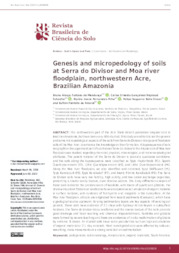Genesis and micropedology of soils at Serra do Divisor and Moa river floodplain, northwestern Acre, Brazilian Amazonia.
Genesis and micropedology of soils at Serra do Divisor and Moa river floodplain, northwestern Acre, Brazilian Amazonia.
Author(s): MENDONÇA, B. A. F. de; SCHAEFER, C. E. G. R.; FERNANDES-FILHO, E. I.; SIMAS, F. N. B.; AMARAL, E. F. do
Summary: The northwestern part of the Acre State (Brazil) possesses singular soils in Brazilian Amazonia, but have been very little studied. This study aimed to discuss the genesis and some micropedological aspects of the soils from Serra do Divisor and adjacent floodplain soils of the Moa river, to enhance the knowledge on their formation. A toposequence of soils ranging from the uppermost part of sub-Andean Serra do Divisor to the Alluvial soils of Moa river floodplain was studied, regarding chemical, physical, mineralogical, and micromorphological attributes. The parent material of the Serra do Divisor is basically quartzose sandstone, and the soils along the toposequence were classified as Typic Haplorthods (P1), Spodic Quartzipsamment (P2), Lithic Quartzipsamment (P3), and Lithic Quartzipsamment (P4). Along the Moa river floodplain, we also identified and collected, Typic Udifluvent (P5), Typic Kandiudult (P6), Typic Kandiudalf (P7), and Arenic Plinthic Kandiudult (P8). The Serra do Divisor soils have very low fertility, high acidity, and low cation exchange capacities, presenting a coarse sandy texture, even shallow pedons. The X-ray diffraction analysis of these soils indicates the predominance of kaolinite, with traces of quartz and gibbsite. The shallow mountain Podzols on sandstone have an expressive accumulation of organic material in surface horizons, with evidence of ferrihydrite and imogolite in the subsurface. At the Moa river floodplain, all soils are originated from recent sediments (Cenozoic), which have a geological source upstream. Varying sedimentary layers are key aspects influencing soil genesis. Those soils have evidence of 2:1 clays with hydroxyl-Al interlayers in subsurface horizons. The Serra do Divisor steep landforms and the coarse texture of the soils promote good drainage and favor leaching and chemical impoverishment. Kaolinite and gibbsite were formed by severe leaching and there are evidences of in situ neoformation of gibbsite by extreme Si losses. All studied soils have some peculiarities such as high accumulation of organic material or 2:1 clay minerals. Most investigated soils were affected by colluvial, reworking, mass movements or a strong variation on sedimentation.
Publication year: 2020
Types of publication: Journal article
Unit: Embrapa Acre
Keywords: Amazonia Occidental, Amazônia Ocidental, Floodplains, Formación del suelo, Gênese do Solo, Llanuras sujetas a inundaciones, Materia orgánica del suelo, Matéria Orgânica, Micropedologia, Micropedology, Mineralogia, Mineralogía del suelo, Northwestern Acre, Planície de inundação, Rio Moa (AC), Serra do Divisor (AC), Soil formation, Soil mineralogy, Soil organic matter, Várzea, Western Amazon
Observation
Some of Embrapa's publications are published as ePub files. To read them, use or download one of the following free software options to your computer or mobile device. Android: Google Play Books; IOS: iBooks; Windows and Linux: Calibre.
Access other publications
Access the Agricultural Research Database (BDPA) to consult Embrapa's full library collection and records.
Visit Embrapa Bookstore to purchase books and other publications sold by Embrapa.

